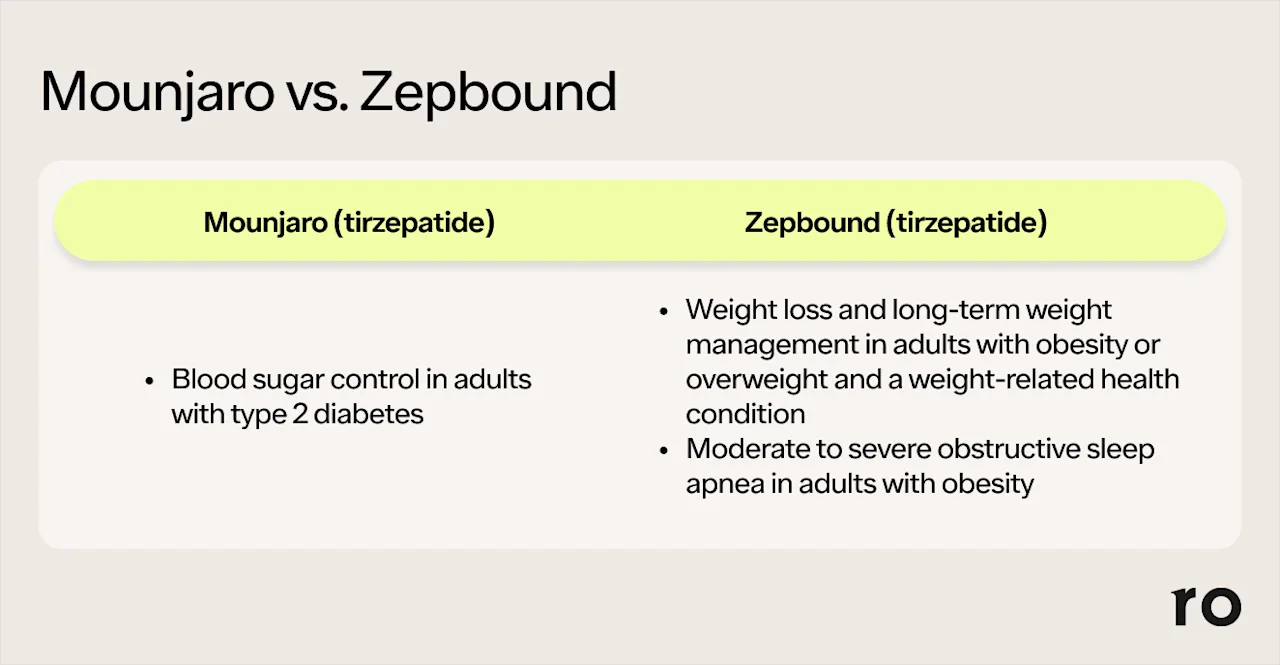Key takeaways
Tirzepatide (Mounjaro and Zepbound) targets two hormones, while semaglutide (Ozempic and Wegovy) targets just one.
Research shows that tirzepatide tends to produce greater weight loss (up to 15% weight loss with tirzepatide vs. 8% with semaglutide after about a year).
Research also shows that tirzepatide tends to produce better blood sugar control than semaglutide.
When switching, you’ll typically start tirzepatide after your last dose of semaglutide.
Even if you were on a high dose of semaglutide, people tend to start on a low dose of tirzepatide (2.5 mg or 5 mg) when switching.
Here's what we'll cover
Key takeaways
Tirzepatide (Mounjaro and Zepbound) targets two hormones, while semaglutide (Ozempic and Wegovy) targets just one.
Research shows that tirzepatide tends to produce greater weight loss (up to 15% weight loss with tirzepatide vs. 8% with semaglutide after about a year).
Research also shows that tirzepatide tends to produce better blood sugar control than semaglutide.
When switching, you’ll typically start tirzepatide after your last dose of semaglutide.
Even if you were on a high dose of semaglutide, people tend to start on a low dose of tirzepatide (2.5 mg or 5 mg) when switching.
Interested in switching from semaglutide to tirzepatide? Understanding the differences between these medications can help you and your healthcare provider decide which one may be right for you, or if it's time to make a move from one to the other.
In this article, we’ll cover how to switch from semaglutide to tirzepatide and answer other frequently asked questions about this process.
What’s the difference between semaglutide and tirzepatide?
Both semaglutide and tirzepatide are once-weekly injections that can treat type 2 diabetes and obesity, when paired with diet and exercise. While they both work on the GLP-1 hormone, semaglutide and tirzepatide differ in three key ways:
Their mechanism of action (aka how they work)
The specific conditions they’re approved to treat
Their effectiveness at treating those conditions
Let’s start by reviewing their mechanism of action (how they work).
Semaglutide’s mechanism
Semaglutide works by mimicking a naturally occurring hormone in your body called glucagon-like peptide-1 (GLP-1) and targeting its receptors throughout your body. That’s why it’s called a GLP-1 receptor agonist.
As a GLP-1, semaglutide drugs like Ozempic and Wegovy work by:
Slowing down how quickly food leaves your stomach
Regulating your appetite by sending signals of satiety (fullness) to your brain
Encouraging your pancreas to release more insulin after you eat
Reducing the amount of glucose produced by your liver
Together, these effects help you feel full longer, reduce cravings, and keep your blood sugar levels in check. All of this explains why these drugs can be so effective at treating obesity and type 2 diabetes.
Tirzepatide’s dual-action mechanism
Tirzepatide mimics GLP-1, just like semaglutide, but it also mimics another hormone called glucose-dependent insulinotropic polypeptide (GIP). This dual-action mechanism is what makes tirzepatide more effective at all the things semaglutide does, including:
Slowing down digestion
Regulating your appetite
Controlling blood sugar by increasing insulin production and inhibiting glucagon
Its dual-action approach is also most likely the reason tirzepatide can provide even greater weight loss and blood sugar control than medications that target only GLP-1, such as semaglutide.
Is tirzepatide more effective than semaglutide?
In a word: yes. Multiple studies have shown that tirzepatide can be more effective than semaglutide at both blood sugar control and weight loss.
But that doesn’t mean it’s the best fit for everybody. Along with its greater weight loss and blood sugar control comes the potential for more intense side effects.
Still, if you haven’t been experiencing benefits on Ozempic or Wegovy, it may be worth switching from semaglutide to tirzepatide to at least give it a try.
Let’s take a closer look at how the two drugs compare.
Weight loss results
Several studies show that tirzepatide consistently beats semaglutide when it comes to weight loss.
For example, according to a study of over 41,000 adults with obesity, people taking tirzepatide:
Were nearly twice as likely to lose at least 5% of their body weight than those taking semaglutide
Were more than twice as likely to lose at least 10% of their body weight, and more than three times as likely to lose at least 15% of their body weight.
Lost more weight at each check-in point during the study (3 months, 6 months, and 1 year)
A separate study of adults with type 2 diabetes had similar findings.
People taking the highest dose of tirzepatide lost nearly 18% of their body weight.
People taking the highest dose of semaglutide, on the other hand, lost about 12.5%.
Blood sugar control
Tirzepatide also appears to do a better job controlling blood sugar than semaglutide, according to research.
In studies comparing Mounjaro vs. Ozempic (the forms of tirzepatide and semaglutide approved for type 2 diabetes):
The two highest doses of tirzepatide drove greater reductions in HbA1c levels than any doses of semaglutide.
Participants also lost about twice as much weight on tirzepatide vs. semaglutide.
How much more does tirzepatide lower blood sugar when compared to semaglutide? Some studies have found that tirzepatide lowers HbA1c levels by an additional 0.15%–0.45%. Other studies have found an even larger difference — almost an entire percentage point!
The difference depends on what dosages of tirzepatide and semaglutide are being used for the comparison. The highest doses of tirzepatide typically results in the greatest differences in HbA1c.
Who might benefit the most from switching from semaglutide to tirzepatide?
People who might benefit the most from switching from semaglutide to tirzepatide include those who:
Haven’t lost as much weight as they hoped to on semaglutide, or have run into a weight loss plateau
Haven’t reached their target HbA1c levels on semaglutide, or are hoping for further reductions
Have another health condition that only tirzepatide is FDA-approved to treat, such as obstructive sleep apnea
If semaglutide hasn’t been working well for you, it might be worth switching to tirzepatide. Even if it has been working well — but not great — it might still be worth a discussion with your healthcare provider.
Research shows that when people make the switch to tirzepatide, they lose even more body weight and achieve better blood sugar control in as little as three months.
Can you switch from semaglutide to tirzepatide?
Yes, you can switch from semaglutide to tirzepatide if you and your healthcare provider decide that tirzepatide would be a better option for you.
The first thing to consider is whether you’re a candidate for tirzepatide based on who it's meant for and what it’s been proven effective to treat.
Taking tirzepatide for an FDA-approved condition can make it easier to get insurance coverage as well. Here’s a quick look at the conditions each version of tirzepatide has been approved for:

Whatever it’s prescribed for, tirzepatide is meant to be taken in combination with lifestyle changes such as diet and exercise.
Why consider switching from semaglutide to tirzepatide?
There are many potential reasons why switching from semaglutide to tirzepatide might be beneficial.
Your weight loss goals
Research suggests that tirzepatide leads to more weight loss than semaglutide.
In a study comparing the two drugs for weight loss, people lost an average of 5.9% of their body weight in three months with tirzepatide, compared to 3.6% with semaglutide. After a year, tirzepatide led to a 15.3% decrease in body weight vs. 8.3% for semaglutide.
While percentages may vary between studies, this could be due to different dosages or different characteristics of the study population. (For example, some studies look at those with diabetes while others look at those without diabetes.) The important thing is that tirzepatide consistently garners better results than semaglutide.
So if you’re not losing weight on semaglutide or think you’ve hit a plateau, tirzepatide could be worth a try.
Your tolerance for side effects
Both tirzepatide and semaglutide have similar side effects, like nausea, vomiting, and diarrhea. These side effects usually subside over time as your body gets used to the medication. But studies show that these side effects are usually — but not always — more common with tirzepatide.
However, everyone's body reacts differently, and studies don’t always predict individual experiences. If you’ve been taking semaglutide and the side effects are too much, you could try switching to tirzepatide to see if it is more tolerable for you. If you continue to experience side effects or find that they worsen, tell your healthcare provider so they can adjust your treatment accordingly.
Your insurance coverage or budget
Both medications are expensive, but tirzepatide costs around $300 less per month based on the retail prices without insurance or discounts.
Zepbound’s list price is $1,086.37 for a month's supply
Wegovy’s list price is $1,349.02 for a month's supply
If cost is a concern, switching could save you money — especially if your insurance covers one medication but not the other. Speak with your healthcare provider and insurance company to get a better understanding of the financial details. (FYI, Ro’s Insurance Checker can also help you figure out coverage — for free!)
Your blood sugar levels
Studies show that tirzepatide outperforms semaglutide in controlling blood sugar levels. If you need additional blood sugar control after trying semaglutide for a while, you might want to consider switching from semaglutide to tirzepatide.
Bottom line: If any of these reasons resonate with you, it might be time to talk with your healthcare provider about making the switch. They can help determine if tirzepatide may be a better fit.
How to safely switch from semaglutide to tirzepatide
The first step to switching from semaglutide to tirzepatide is to schedule an appointment with a healthcare provider.
Tell the provider that you’re interested in switching to tirzepatide and why. They’ll likely want to discuss how well you’ve tolerated semaglutide, your weight loss progress, and whether you’re meeting your health goals.
If they recommend switching from semaglutide to tirzepatide, your healthcare provider will guide you through the process. Here’s what you can expect.
1. Stop semaglutide 3–10 days before the switch
Both tirzepatide and semaglutide are injected under the skin (subcutaneously) once a week. If you switch from one to the other, it’s likely you’ll start tirzepatide one week after your last dose of semaglutide.
In research involving people with type 2 diabetes who switched from semaglutide to tirzepatide, participants stopped semaglutide 3–10 days before starting tirzepatide.
Your healthcare provider will provide you with specific instructions on how to time your switch from semaglutide to tirzepatide.
If you still have semaglutide left, you shouldn’t continue to use it with tirzepatide. The drug label advises against using tirzepatide with other weight loss treatments, including GLP-1 agonists.
That’s because there’s not enough research on the efficacy or safety of combining them. You could increase the risks of dangerous side effects by combining treatments against the advice of your healthcare provider, so be sure to follow their recommendations closely.
2. Begin tirzepatide at the recommended dose
Just like semaglutide, tirzepatide follows a gradual dosing schedule. Meaning, you will start at a low dose and work your way up over several weeks or months. This gives your body time to get used to the medication until you reach an effective maintenance dose.
Even if you were on a higher dosage of semaglutide, your healthcare provider may have you start at the recommended starting dosage of 2.5 mg weekly for tirzepatide. Then, about every four weeks, they may increase your dose by another 2.5 mg until you land on a maintenance dose that works well for you and keeps side effects manageable. The maximum dose of tirzepatide is 15 mg weekly.
It’s also possible your provider will have you start at a higher dose. In clinical studies, people successfully made the switch by starting at a 5 mg dose of tirzepatide. Side effects were manageable, and researchers concluded that this higher starting dose was safe.
The bottom line? Your healthcare provider will decide your starting dosage for tirzepatide and prescribe it accordingly. As with all medications, be sure to take it as prescribed.
3. Expect some side effects
As you probably know from taking semaglutide, GLP-1s can cause side effects. The same is true for tirzepatide.
In an aforementioned study, about 13% of people experienced gastrointestinal (GI) side effects like nausea, constipation, and diarrhea after switching to tirzepatide.
Tirzepatide’s side effects are similar to semaglutide and may include:
Nausea
Vomiting
Constipation
Stomach pain
Indigestion
Injection site reactions
Allergic reactions
Belching
Heartburn
It’s important to be aware of these side effects and report any new or severe symptoms to your provider.
What happens to the dosage when you switch?
Your healthcare provider will recommend a starting dosage of tirzepatide for you.
Some providers may have you start at the lowest dose of 2.5 mg of tirzepatide weekly; others may have you start at the next highest dose of 5 mg weekly. Studies have shown that 5 mg is safe and well-tolerated by people switching from semaglutide to tirzepatide.
Your healthcare provider will personalize your initial dose based on individual factors such as how you respond to medication and your tolerance to side effects. Over time, your healthcare provider will gradually increase your dosage based on your response to the medication, any side effects you experience, and treatment goals. Stick to their recommendations and work closely with them to determine your dosing plan.
Potential side effects and risks during transition
Both tirzepatide and semaglutide can cause side effects. On the drugs, side effects tend to be worse at the beginning of treatment and when increasing your dose, then gradually improve with time.
If you’re switching to tirzepatide, you may experience those side effects again and in fuller force. In a study of people who switched from semaglutide to tirzepatide, the most common side effects were nausea, constipation, and diarrhea. They ranged from mild to moderate in intensity.
It’s also possible that you might experience more — or more intense — side effects on tirzepatide. Studies generally show that GI side effects are more common on tirzepatide, especially on higher doses. Serious side effects are also slightly more common on tirzepatide.
If you have concerns about side effects during the transition or afterward, consult your healthcare provider. They can help you better understand your risk and offer guidance for managing side effects.
Bottom line
If you’re thinking about switching from semaglutide to tirzepatide, talk to your healthcare provider. Research suggests tirzepatide can lead to up to 1.5–2 times more weight loss and improved blood sugar control.
Tirzepatide works differently than semaglutide. Since it targets two hormones (GLP-1 and GIP) instead of just one (like semaglutide), it can be more effective for weight loss and blood sugar control.
You may lose more weight. Studies show that people taking tirzepatide lose significantly more body weight, which may be especially helpful if you’ve hit a plateau on semaglutide.
Blood sugar control may improve. Even at lower doses, tirzepatide can reduce HbA1c more than the highest doses of semaglutide.
Side effects can be more common. While both medications cause GI symptoms like nausea and diarrhea, tirzepatide may trigger these more often.
Cost and insurance coverage matter. Tirzepatide’s retail price is slightly lower than semaglutide’s, but coverage varies. Always check your plan before switching.
Frequently asked questions
What are the equivalent doses of semaglutide and tirzepatide?
Both semaglutide and tirzepatide typically start with a dose escalation phase where you begin with the lowest dose and work your way up to the maintenance dose over the first few months of treatment. The Wegovy dosage ranges from 0.25 mg to 2.4 mg per week, while Ozempic ranges from 0.25 mg to 2 mg per week. Both forms of tirzepatide, Mounjaro and Zepbound, come in the same dosage amounts ranging from 2.5 mg up to a maximum of 15 mg per week.
Is tirzepatide more effective than semaglutide?
Tirzepatide has outperformed semaglutide in studies. One study compared weight loss results in adults with overweight or obesity based on data from medical records. The results showed that, on average:
At three months, people taking tirzepatide experienced a 5.9% weight loss, compared to 3.6% for those on semaglutide.
At six months, people taking tirzepatide saw a 10.1% weight loss, while those taking semaglutide lost 5.8%.
By 12 months, the weight loss was 15.3% for tirzepatide and 8.3% for semaglutide.
Keep in mind that real-life results can vary from person to person.
Is tirzepatide safer than semaglutide?
Tirzepatide and semaglutide cause similar side effects, with the most common ones being nausea, vomiting, and diarrhea. In general, research shows higher rates of these side effects with tirzepatide. And people are more likely to have intolerable gastrointestinal effects with higher doses of tirzepatide. Both drugs carry similar risks and warnings, such as hypoglycemia (low blood sugar), especially if used with certain diabetes medications.
Is tirzepatide less expensive than semaglutide?
Yes, tirzepatide appears less expensive when comparing the retail prices. Without insurance, Wegovy (semaglutide) costs $1,349.02 per month, and Zepbound (tirzepatide) costs $1,086.37 per month. Your actual cost may be different depending on insurance coverage, eligibility for assistance programs, use of discount cards, and other factors.
Is tirzepatide easier to use than semaglutide?
Both Wegovy and Zepbound come in single-use prefilled autoinjector pens. The administration steps are very similar and easy for both. Zepbound also has an option of single-dose vials, a form that requires you to use a syringe to inject each dose, which involves a few more steps.
Can I switch from semaglutide to tirzepatide?
Yes, you can switch from semaglutide to tirzepatide if you and your healthcare provider agree that it’s a good fit for you. Reasons for switching include:
More weight loss or blood sugar control (studies show tirzepatide is more effective for both of these outcomes)
Budget
Insurance considerations
What is the safest way to switch from semaglutide to tirzepatide?
The safest way to switch from semaglutide to tirzepatide is under the guidance of your healthcare provider. Based on your medical history and health goals, your provider can determine whether tirzepatide may be an effective treatment for you. Then, if you do switch, they can recommend when to stop semaglutide, when to start tirzepatide, and what dosage to take.
Does insurance cover switching from semaglutide to tirzepatide?
It depends. In general, insurance coverage varies for GLP-1 medications like semaglutide and tirzepatide. To understand if your insurance will cover the switch, contact your insurance provider directly. Also, ask them if prior authorization will be required, what conditions the medication is covered for, and what your copay will be.
DISCLAIMER
If you have any medical questions or concerns, please talk to your healthcare provider. The articles on Health Guide are underpinned by peer-reviewed research and information drawn from medical societies and governmental agencies. However, they are not a substitute for professional medical advice, diagnosis, or treatment.
GLP-1 Important Safety Information: Read more about serious warnings and safety info.
Ozempic Important Safety Information: Read more about serious warnings and safety info.
Wegovy Important Safety Information: Read more about serious warnings and safety info.
Mounjaro Important Safety Information: Read more about serious warnings and safety info.
Zepbound Important Safety Information: Read more about serious warnings and safety info.
References
Almandoz, J. P., Lingvay, I., Morales, J., & Campos, C. (2020). Switching between glucagon-like peptide-1 receptor agonists: rationale and practical guidance. Clinical Diabetes: a Publication of the American Diabetes Association, 38(4), 390–402. doi: 10.2337/cd19-0100. Retrieved from https://www.ncbi.nlm.nih.gov/pmc/articles/PMC7566932/
Azuri, J., Hammerman, A., Aboalhasan, E., et al. (2023). Tirzepatide versus semaglutide for weight loss in patients with type 2 diabetes mellitus: A value for money analysis. Diabetes, Obesity & Metabolism, 25(4), 961–964. doi: 10.1111/dom.14940. Retrieved from https://dom-pubs.onlinelibrary.wiley.com/doi/full/10.1111/dom.14940
Collins, L. & Costello, R. A. (2024). Glucagon-like peptide-1 receptor agonists. StatPearls. Retrieved from https://www.ncbi.nlm.nih.gov/books/NBK551568/
Eli Lily. (2025). How much should I expect to pay for Zepbound® (tirzepatide)?. Retrieved from https://pricinginfo.lilly.com/zepbound
Fisman, E. Z. & Tenenbaum, A. (2021). The dual glucose-dependent insulinotropic polypeptide (GIP) and glucagon-like peptide-1 (GLP-1) receptor agonist tirzepatide: a novel cardiometabolic therapeutic prospect. Cardiovascular Diabetology, 20(1), 225. doi: 10.1186/s12933-021-01412-5. Retrieved from https://cardiab.biomedcentral.com/articles/10.1186/s12933-021-01412-5
Frías, J. P., Davies, M. J., Rosenstock, J., et al. (2021). Tirzepatide versus Semaglutide Once Weekly in Patients with Type 2 Diabetes. The New England Journal of Medicine, 385(6), 503–515. doi: 10.1056/NEJMoa2107519. Retrieved from https://www.nejm.org/doi/10.1056/NEJMoa2107519
Jabbour, S., Paik, J. S., Aleppo, G., et al. (2024). Switching to Tirzepatide 5 mg From Glucagon-Like Peptide-1 Receptor Agonists: Clinical Expectations in the First 12 Weeks of Treatment. Endocrine Practice: Official Journal of the American College of Endocrinology and the American Association of Clinical Endocrinologists, 30(8), 701–709. doi: 10.1016/j.eprac.2024.05.005. Retrieved from https://www.endocrinepractice.org/article/S1530-891X(24)00515-9/fulltext
Karagiannis, T., Malandris, K., Avgerinos, I., et al. (2024). Subcutaneously administered tirzepatide vs semaglutide for adults with type 2 diabetes: a systematic review and network meta-analysis of randomised controlled trials. Diabetologia, 67(7), 1206–1222. doi: 10.1007/s00125-024-06144-1. Retrieved from https://link.springer.com/article/10.1007/s00125-024-06144-1
Kommu, S. & Whitfield, P. (2024). Semaglutide. StatPearls. Retrieved from https://www.ncbi.nlm.nih.gov/books/NBK603723/
Mishra, R., Raj, R., Elshimy, G., et al. (2023). Adverse Events Related to Tirzepatide. Journal of the Endocrine Society, 7(4), bvad016. doi: 10.1210/jendso/bvad016. Retrieved from https://www.ncbi.nlm.nih.gov/pmc/articles/PMC9915969/
NovoCare. (2025). What Is The List Price For Wegovy® And Will It Impact Me? Retrieved from https://www.novocare.com/obesity/products/wegovy/let-us-help/explaining-list-price.html
Rodriguez, P. J., Goodwin Cartwright, B. M., Gratzl, S., et al. (2024). Semaglutide vs Tirzepatide for Weight Loss in Adults With Overweight or Obesity. JAMA Internal Medicine, e242525. doi: 10.1001/jamainternmed.2024.2525. Retrieved from https://www.ncbi.nlm.nih.gov/pmc/articles/PMC11231910/
U.S. Food and Drug Administration (FDA-a). (2025). Highlights of Prescribing Information: Mounjaro (tirzepatide) injection, for subcutaneous use. Retrieved from https://www.accessdata.fda.gov/drugsatfda_docs/label/2025/215866s031lbl.pdf
U.S. Food and Drug Administration (FDA-b). (2025). Highlights of Prescribing Information: Ozempic (semaglutide) injection, for subcutaneous use. Retrieved from https://www.accessdata.fda.gov/drugsatfda_docs/label/2025/209637s025lbl.pdf
U.S. Food and Drug Administration (FDA-c). (2025). Highlights of Prescribing Information: Wegovy (semaglutide) injection, for subcutaneous use. Retrieved from https://www.accessdata.fda.gov/drugsatfda_docs/label/2025/215256s024lbl.pdf
U.S. Food and Drug Administration (FDA-d). (2025). Highlights of Prescribing Information: Zepbound (tirzepatide) injection, for subcutaneous use. Retrieved from https://www.accessdata.fda.gov/drugsatfda_docs/label/2025/217806Orig1s020lbl.pdf














